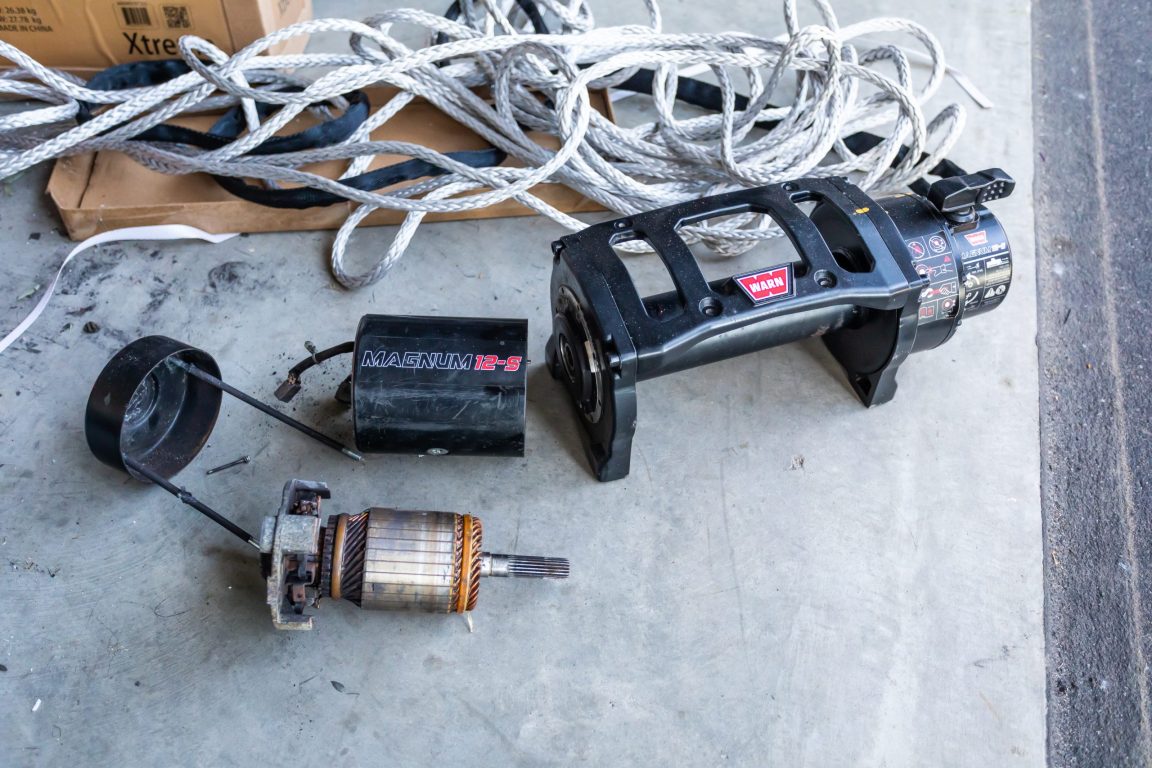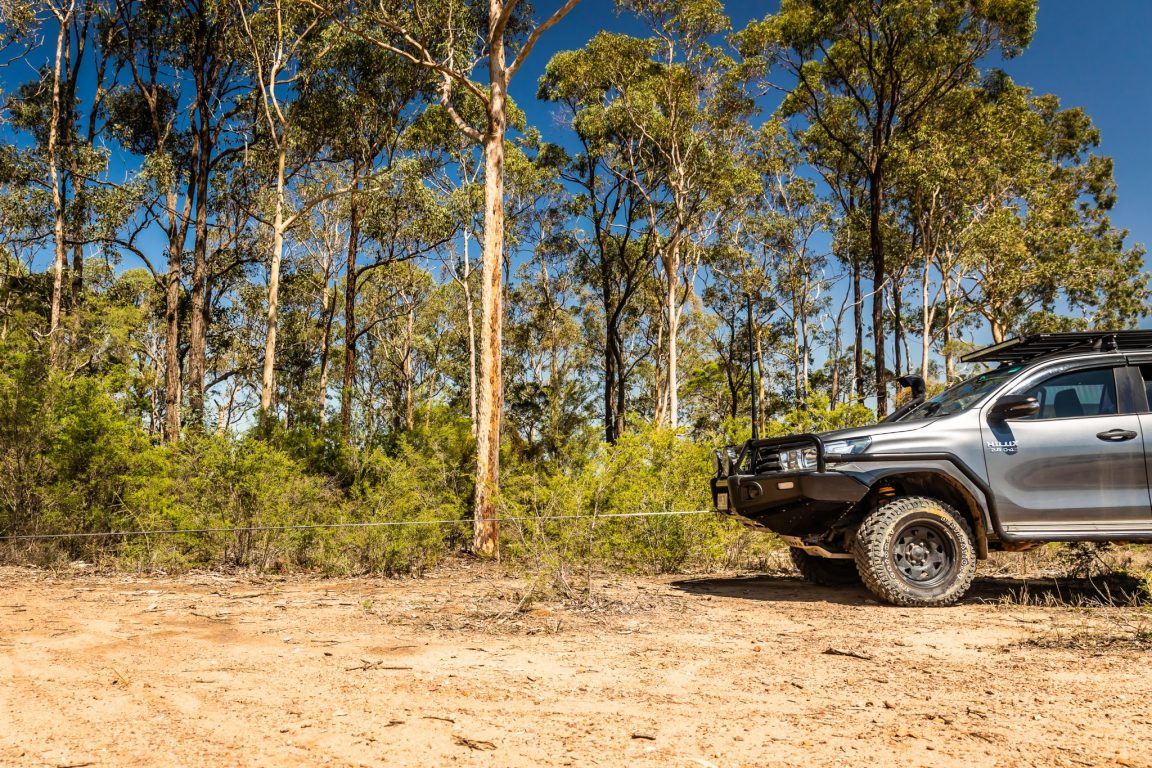Advertisement
Advertisement
Imagine this. All you know is there’s a stuck 4X4, and you need to recover it. You have no idea what 4X4 it is. Where it is. Or how it’s stuck. But you must go and recover it. Now I’m going to offer you a choice of two winches; a hand winch, Tirfor-style. Or I’ll magically install an electric on the front of the stuck fourby. Which one will you choose?
Ideally, you’d have both, but your wizard is only clever enough to magic you just the one. So let’s think about the options.
An electric winch is what you see on most 4X4s because I don’t think people have thought enough about exactly this situation. Electrics are a one-trick pony. Superb at pulling in a straight line, and they can do a bit of redirection using snatch blocks. But you cannot, realistically, pull the car backwards or sideways, and you pretty much have to take the car to the problem if it’s not you that needs help. Electrics are also heavy, and as they aren’t often used they’re prone to failing just when you most need them due to a lack of winch maintenance. And they need battery power too, plus the engine running for any extended use.

Contrast this inflexibility with the humble hand winch, which can pull from any angle, and move from place to place. And you don’t know how you’re stuck, so maybe a small tug backwards would be the go, or a drag sideways into the ruts you slipped from. Many recoveries don’t involve dragging a car up a hundred metres of slippery rock. It could be that you don’t even need to winch the car. Just secure it on a hill so you can change a tyre. And hand winches are simpler and protected from the elements, so they tend to be reliable.
But the big problem with hand winches, at least the one I own, is the motor. It’s pretty awful – weak, doesn’t run for long, prone to swearing. This is the major objection to hand winches, and it’s fair enough. Yet I also think there’s an element of “look” associated with an electric which does say rough, tough adventure truck in a way a hand winch doesn’t. To say nothing of the halo effect as people see competition trucks hauling themselves up near-vertical grades. By the way, comp truck winches are as different from your recreational winch as a softroader is from your low-range 4X4. So don’t think you too can winch up a hill faster than you can walk it.
Let’s now get back to the recovery situation. Clearly, the flexibility of the hand winch makes it a winner. What of the motor? Well, in many situations you only need to move the car maybe a metre or two, which to be honest isn’t that hard for even the weediest off-roader. You’d need more strength to lift the spare wheel. And most 4X4 trips also have several people on hand to help, plus in a recreational situation you’re not generally pushed for time, either. Sometimes it is entirely possible to set up a hand winch and recover a vehicle before you’ve manoeuvred a vehicle with an electric winch into position.
So if it was me taking on the recovery challenge, I’d take a hand winch because of the flexibility, and nobody said anything about a time challenge. I’d have both of course – I own and use one of each, sometimes together – and my method is to use the electric where I can, but the hand winch where I can’t or where it’s better, and that’s surprisingly often.
Use me or lose me! That’s what the winch is silently screaming each time you go four-wheel driving.
Yet how often do any of us use the electric winch that has been so expensively added to the front of our 4X4s? Rarely, if at all, would be the answer covering the vast majority of winch owners.
But not using your winch is like not cuddling or playing with your kids when they’re growing up. Eventually, when you need their help, they’re not there for you – or if they are, they’re very badly behaved. And winches are nearly as expensive as kids!
A winch that sits lonely and neglected on your bullbar becomes a stiff, dirty, sullen, anti-social creature with arthritic joints, clogged arteries, corroded guts and a weak ticker.
Craig McFayden, the foreman at ARB’s Wentworthville workshop in Sydney, uses a bloke who has sat on his lounge for weeks without moving as his winch metaphor. “When he goes to get up, it’s pretty hard.”
Just like humans, a winch is happiest when it gets plenty of exercise, a healthy diet and washes regularly. Seeing the whole point with winch maintenance here?

Craig cracked open a winch for Unsealed 4X4 and sighed at the sad sight confronting us. The internals were clogged and corroded thanks to mud and salt. The grease that should have kept everything purring was dried out, clotted and full of dirt. The synthetic rope was dirty and damaged because it had not been washed or wound on properly. Clear indicators of a lack of winch maintenance.
What many people fail to appreciate is that their winch and its internal workings are not completely sealed off from the elements. Even rain or washing your 4X4 can lead to moisture inside your winch. Drive along a beach and you get corrosive salt inside your winch. Cross a creek and you get mud in the same place.
If you don’t use your winch, this salt and mud and inactivity can render it useless in a disturbingly short space of time.
After each 4X4 outing, simply by flicking the clutch lever from engaged to disengaged and pulling out some rope, you are keeping things moving rather than allowing them to be frozen up by dried mud and corrosion. Just by turning on the electric motor and winding that rope back in under strain, you are keeping the grease moving over all the parts and producing enough heat to evaporate the water inside the motor that would otherwise exacerbate corrosion.
The winch on Craig’s 75 Series Toyota Troopy is 15 years old, and he has no doubt it will last another 15 years because he operates and maintains it properly.
So here are Craig’s tips for getting the best out of your winch:
Make sure the rope has been wound tightly under strain onto the drum in the first place. If this is not done, when you use the winch to haul yourself out of trouble the rope will pull through the loose spools straight to the drum, damaging the rope and reducing the pulling power of your winch.
If sections of your rope are squashed flat rather than round, this is what has happened. This can also lead to a jammed rope that forces the engine to work harder, making things so hot that the synthetic rope could melt.
Make sure the rope is wound evenly and neatly back onto the drum. Unevenly spooled rope (where it creates a “bird’s nest” at one end of the drum) can similarly reduce the pulling power of your winch and lead to overheating problems.
Don’t ever let out all your rope when winching. Leave at least one layer on the drum or else your winch won’t work at maximum efficiency. Grab an extension strap instead of going all the way to the drum.

After every 4X4 outing, or else every three months it’s time for some winch maintenance. Flick the clutch to free spool the rope from your winch. Then give the rope and the winch a thorough rinse with your hose. A clean rope is stronger and more effective. The water will also help rinse dirt and salt from inside the winch and stop the drainage hole on the electric motor from getting clogged up.
Let the rope dry for a bit before winding it back on, but don’t leave it in the bright sun for too long. Ultra-violet light will degrade synthetic rope.
Metal cable is more robust and requires less maintenance than sythenthic rope, but is much heavier and not as user-friendly.
If you change from cable to synthetic rope, get rid of any abrasion the cable caused to the drum or this will damage your synthetic rope.
If you have steel cable, do not grease it as this will allow dirt to more easily stick to it.
Make sure that the rope is wound back on evenly and under strain. A good way of doing this is have your 4X4 downhill from the anchor point. If you are on flat ground, have your vehicle’s hand brake on a few clicks to ensure a tight spooling.
Get your winch serviced every two years. ARB does winch maintenance for about $300. If you are doing it yourself, thoroughly clean everything, remove any corrosion and give it a coating of high-temperature grease. Even well-maintained rope or cable won’t last forever. Closely monitor their condition and pay head to manufacturer’s recommendations on safe working life expectancy.
“Just like humans, a winch is happiest when it gets plenty of exercise, a healthy diet and washes regularly.” Haha… It is funny!
I had a Ballands 1200 lb winch and my Jeep wrangle XJ. They are enough for the long off-road tour! Thanks for the greate post!
With the use of 3 snach blocks you can winch ether side ways or back. So saying you cant is not right
The 9000 lbs Badland winch I have on my Jeep works for a few minutes but then quits. This occurs if I’m pulling a stuck truck or a mini van in neutral up a flat driveway. Where do I take it to get serviced? Badland doesn’t seem to have their own web site.
Exactly. Here’s the procedure for pulling your 4×4 backwards with your own winch:
1. Shovel.
2. More Shovel.
3. Spool cable/rope out to the first wrap.
4. Set up all your rigging with the snatch blocks, extensions, etc.
5. Hook up to your rear recovery point. Double check your rigging.
6. Get in the driver’s seat, check steering angles.
7. Activate winch.
8. Receive harsh reminder of Newton’s Third Law.
9. Enjoy your new pair of 2×2’s.